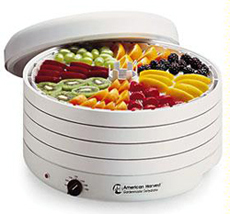TIP OF THE DAY: Home Dehydrating
|
Chef Johnny Gnall hasn’t made kale chips yet (see the review), but he does dehydrate. Dehydrated foods are used in a myriad of applications, says Chef Johnny. From Michelin-star kitchens to backwoods cabins full of deer jerky, people have long been removing the moisture from their food in a variety of ways. The technique began thousands of years, initially to preserve meat and other foods. You can purchase a dehydrator (they’re reasonably priced—here’s a good model) and dehydrate your favorite fruits and veggies into crisp snacks—with no preservatives, sugar or salt. You can also dry meat, fish, granola, herbs and flowers (to decorate cakes or make your own potpourri and sachets). It‘s easy to get hooked on dehydrating. |
 You don’t need a dehydrator like this one, but it helps! Photo courtesy Nesco. |
|
|
But unless you plan to make a lot of jerky or dried fruit and veggie snacks, an electric dehydrator may not be worth the space it takes up. If you simply want to experiment at home, just head to the hardware store for a dessicant. A desiccant—familiar as the small, white silica gel packets placed in some packages of foods and in boxes of shoes—absorbs moisture. Desiccants are made in a variety of forms but not all are safe near food. So go for the small white packets, which are. Then, all you need is some cheesecloth, a plastic food storage container and an airtight plastic bag to place it in. What food should you dehydrate? Stick to fruits and vegetables. This simple technique isn’t successful for jerky. RECIPE: DEHYDRATED CITRUS RIND While dehydrated citrus rind isn’t a snack like dried apple chips or carrot slices, it will provide you with a delicious seasoning that works in certain situations that don’t work with fresh lemon, lime, grapefruit or orange zest. A favorite way to use dehydrated citrus rind is to grind it and add it to savory rubs for meat and fish. Try it finely ground in whipped cream: It will add an earthy twist to your favorite dessert. Experiment with your daily recipes to see where it best adds a flavor spark. Dried foods have a long shelf life in airtight containers, so you can fill your shelves with little jars of your creations for creative cooking. You may find yourself unlocking some unique flavors. Preparation |
||


